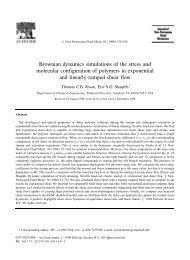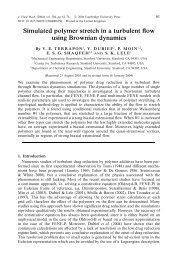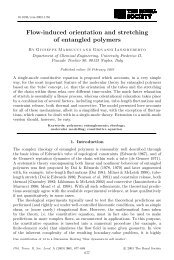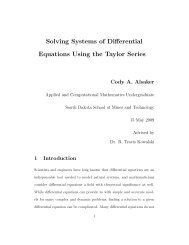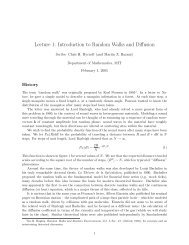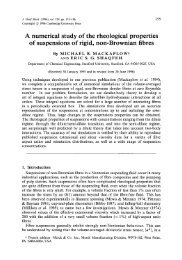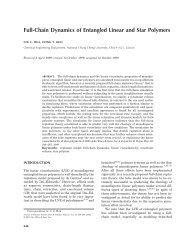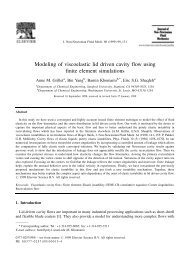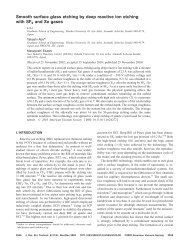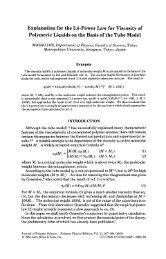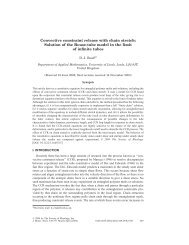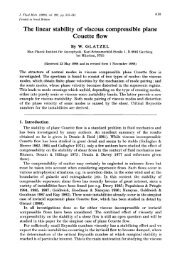Molecular modelling of entangled polymer fluids under flow The ...
Molecular modelling of entangled polymer fluids under flow The ...
Molecular modelling of entangled polymer fluids under flow The ...
Create successful ePaper yourself
Turn your PDF publications into a flip-book with our unique Google optimized e-Paper software.
18 CHAPTER 2. INTRODUCTION TO MOLECULAR RHEOLOGY<br />
small enough that all quantities can be considered to be homogeneous inside the cube.<br />
This situation is illustrated in figure 2.3. A subchain inside such a cube has its end to<br />
end vector denoted by r n where n labels the bead number. This subchain will cross a<br />
plane with normal in the α direction with probability r nα /L (α and β denote Cartesian<br />
components). If the chain carries a tension F n then the force in the β direction caused<br />
by this chain is F nβ . Note that both the end to end vector and the tension depend<br />
upon bead number. <strong>The</strong> total <strong>polymer</strong> contribution to stress is obtained by summing<br />
over all subchains inside the cube. This is achieved by summing over all chains and all<br />
bead numbers,<br />
σ αβ = 1 L 3<br />
∑<br />
chains,n<br />
r nα F nβ . (2.10)<br />
If the cube contains enough chains the sum over chains can be replaced by an ensemble<br />
average 〈...〉. This average is over all subchains with the same bead position within the<br />
same course-graining volume. An average over bead positions is not taken. <strong>The</strong> cube<br />
will contain cL 3 /N chains (c is the monomer density) thus the <strong>polymer</strong> contribution<br />
to stress inside this cube is<br />
σ αβ = c ∑<br />
〈r nα F nβ 〉 . (2.11)<br />
N<br />
n<br />
<strong>The</strong> tension, F n , is a known function <strong>of</strong> the local chain configuration (equation 2.7).<br />
Taking the continuous limit allows the sum over beads to be replaced by an integral<br />
along the chain contour and r n by the first derivative <strong>of</strong> the chain space-curve. This<br />
leads to the final expression for the stress<br />
σ αβ = c N<br />
3k B T<br />
b 2<br />
∫ N<br />
0<br />
〈 ∂Rα<br />
∂n<br />
〉<br />
∂R β<br />
dn. (2.12)<br />
∂n<br />
2.2.7 Non-linear constitutive equation<br />
A non-linear constitutive equation can be constructed from the Rouse model in the<br />
following way [Larson (1988)]. Beginning with the continuous representation <strong>of</strong> equation<br />
2.8<br />
( )<br />
∂R<br />
ζ 0<br />
∂t − κ .R = 3k BT<br />
≈ b 2<br />
∂ 2 R<br />
+ f(n, t). (2.13)<br />
∂n2 <strong>The</strong> quantity f(n, t) represents the local Brownian forces acting on an individual beads,<br />
which are assumed to be random and isotropically distributed. Thus the forces act<br />
equally in all directions and are uncorrelated in time and position along the chain.<br />
<strong>The</strong> size <strong>of</strong> the force is fixed by insisting that all points on the chain are in thermal



